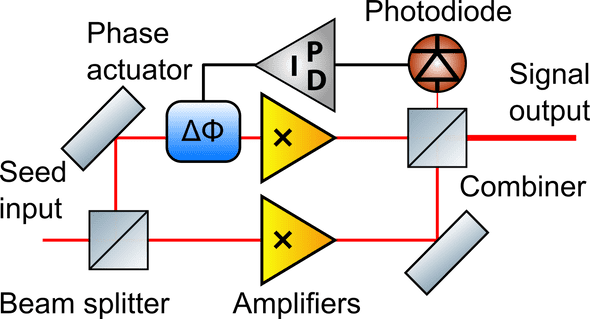Coherent Beam Combining
June 09, 2016
Some laser applications require sources which a single laser emitter cannot deliver at this time. Coherent beam combining offers an a way to solve this problem by brute force. Instead of using a single laser system one combines multiple ones (usually fiber amplifiers) to one powerful beam. Typical single frequency or femtosecond fiber amplifers can reach output power levels of 300 W.

Four of them would lead to 1.2 kW of total available output power with reasonable system complexity. However, the four beams have to be combined and the beam quality has to be preserved in the process. This can be achieved with CBC. As long as two output beams have the correct phase relationship, a 50:50 beam splitter can be used as a combining element (Fig. 1) and the complete output power is available at one output port. The most common geometry for coherent beam combining of fiber amplifiers is depicted in Fig. 1. It is essentially a Mach-Zehnder interferometer with amplifiers placed in the interferometer arms. For a combination of pulsed amplifiers the Sagnac geometry can be advantageous . In this case the phase relationship of the beams is intrinsically stable. Therefore, the equations known from for the Mach-Zehnder interferometer can also be applied for CBC.
To calculate the output power at one port of the system, both electric fields have to be overlapped. At the other output port the relative phase between both waves is shifted by . If both fiber amplifiers operate at the same output power , this leads to
Here is the total relative phase between both fields. Therefore, the detected power at this output port is
The whole power is combined at this output port, if can be maintained with being an integer. For this it is necessary to detect and actively stabilize the relative phase between both optical paths, because mechanical vibrations and amplifier phase noise lead to fluctuations.
If the interferometer is locked to maximum output power, there are important implications for the impact of residual phase noise. Expansion of the cosine leads to
Therefore, the mean output power is . Hence, for less than 1% combining loss a phase variance is required. Of course the phase variance is not the only aspect to consider for combining efficiency. Other reasons for decreased combining efficiency include relative mis-modematching, nonuniform powers and polarization errors. A detailed analysis of those effects was reported by Goodno et al.
The CBC concept can be extended to many amplifiers as shown in Fig. 2. In this case there are different concepts concerning the combining element. A tiled aperture combining element only overlaps the beams in the far field. This results in imperfect beam quality, but the beam can be steered using phase control. In the case of fiber amplifiers this can be realized by stacking the fiber ends close to each other. Since the resulting beam quality is limited, this is not a useful method for laser systems for GWDs. To realize the best possible beam quality, the beams have to be overlapped in both near and far field. This can be realized by stacking 50% splitters or by using gratings or fiber couplers.
Therefore we are now only limited by the power handling capability of the combining element, which especially in the case of mirrors can be very large.
(This is a reproduction and small update from my PhD thesis.)